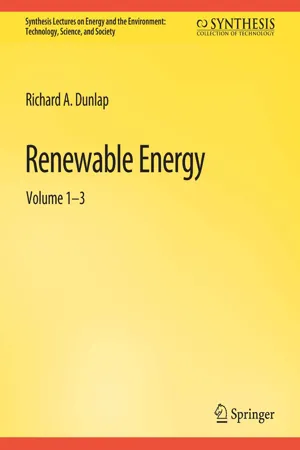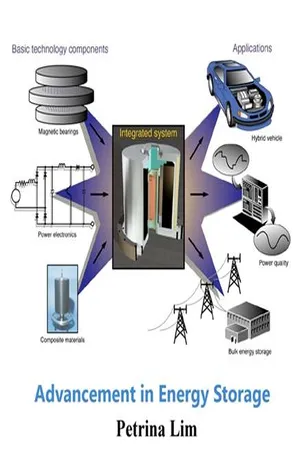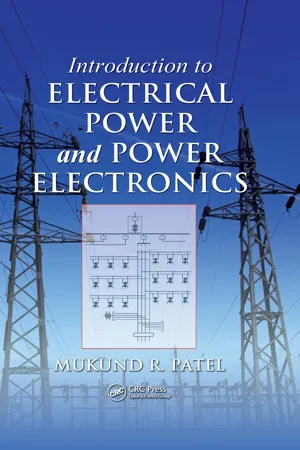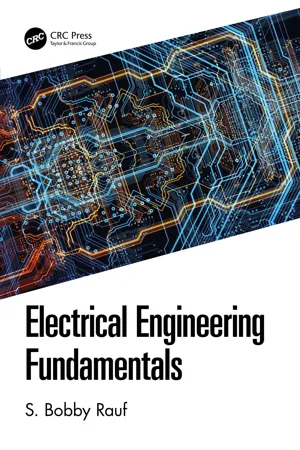Physics
Batteries
Batteries are devices that store chemical energy and convert it into electrical energy. They consist of one or more electrochemical cells, each containing positive and negative electrodes separated by an electrolyte. When a circuit is connected, chemical reactions occur at the electrodes, generating a flow of electrons and producing electrical power.
Written by Perlego with AI-assistance
Related key terms
1 of 5
11 Key excerpts on "Batteries"
- eBook - PDF
Renewable Energy
Volumes 1 – 3
- Richard A Dunlap(Author)
- 2022(Publication Date)
- Springer(Publisher)
1 CHAPTER 1 Batteries 1.1 INTRODUCTION Batteries are probably the best-known energy storage device. We encounter them in a wide variety of applications in our daily lives. They power electronic devices such as watches, cell phones and notebook computers and are used to start gasoline and diesel-powered vehicles. Batteries store energy using electrochemical reactions and a large fraction of those that we encounter utilize reac- tions that are reversible, meaning that the Batteries can be recharged. The present chapter gives an overview of the common types of Batteries that are in use, as well as some types of Batteries that are in the early stages of development and commercialization. It also provides a brief description of the physics and chemistry of how Batteries work. Finally, some important battery applications are presented. 1.2 TYPES OF Batteries The terms “cell” and “battery” are sometimes used ambiguously or interchangeably, but both have fairly well-defined meanings. A cell is an electrochemical unit containing two electrodes and an electrolyte that provides a means of storing energy by electrochemical reactions. A battery is one or more electrochemical cells with appropriate packaging so as to constitute a practical device that is suitable for use in applications. In the present section, Batteries are considered in terms of their overall characteristics. In the next section cells, with particular reference on Li-ion cells, are dis- cussed in terms of the fundamental physics and chemistry of their operation. Batteries may be categorized in different ways. One approach is to divide Batteries into two categories: non-rechargeable and rechargeable. Non-rechargeable Batteries are referred to as pri- mary Batteries and rechargeable Batteries are referred to as secondary Batteries. Another approach to categorizing Batteries is on the basis of their chemistry. - Keith Scott(Author)
- 2017(Publication Date)
- Wiley(Publisher)
233 7 Electrochemical Energy Storage and Power Sources This chapter describes the operating characteristics and mechanisms and materials used in a range of electrochemical energy storage and power generation devices including Batteries and supercapacitors, redox flow cells and biological fuel cells. The description is complementary to that in Chapter 8 which describes in specific detail the characteristics and principles of operation of a range of fuel cell technologies. 7.1 Batteries Batteries are a means of storing energy through the use of suitably active chemical species (Linden and Reddy, 2001). As described in Chapter 2, when these species are allowed to react spontaneously in an electrochemical cell they generate electrical energy to power specific devices. Generally Batteries are classified as either primary or secondary cells. Primary cells utilize the battery chemicals once and when discharged are not reusable. Secondary Batteries have the ability to be used repeatedly; they can be recharged, that is restored to their initial condition, for reuse. This recharging is achieved by reversing the cell electrode reactions by the application of current (and a negative cell potential greater than the thermodynamic equilibrium cell potential) in the reverse direction to that during discharge (or use). Primary battery applications are mainly in watches, remote controls, transmitters, pacemakers for heart patients, and in applications when charging is impractical or impossible, such as military combat, rescue missions. Such applications require the battery to have high specific energy, long storage times and operational readiness. Two standard primary Batteries are c arbon–zinc (also known as the Leclanché battery ) and the alkaline–manganese , or alkaline for short. Alkaline delivers more energy at higher load currents than carbon–zinc.- eBook - PDF
- Thomas F. Fuller, John N. Harb(Authors)
- 2018(Publication Date)
- Wiley(Publisher)
Chapter 7 Battery Fundamentals Energy storage using Batteries is an essential feature for numerous technologies, and applications of Batteries are widespread in society. The necessity of energy storage includes cases where portability is desired, emergency power is required, or simply when electrical demand and supply are not matched. The battery is such an energy storage device—converting between chemical and elec- trical energy. For Batteries to be practical, the conversion must be nearly reversible; that is, the reactions must occur with a low overpotential. This near reversibility allows for most of the chemical energy in the battery to be converted into electrical energy that performs useful work. In this chapter, the fundamental characteristics of Batteries are covered. Applications and engineering design are discussed in the next chapter. As with other electrochemical systems, our convention will be to put the more negative electrode on the left. Generally, the reactions will be written as discharge reactions, but remember that for rechargeable Batteries the reactions are reversed on charge. 7.1 COMPONENTS OF A CELL Figure 7.1 shows a simple electrochemical cell known as the Daniell cell (1839). Here zinc is oxidized at one electrode and copper ions reduced at the other: Zn ! Zn 2 2e Cu 2 2e ! Cu The main components of a cell are the negative electrode (zinc bar), the positive electrode (copper bar), and the electrolyte. The electrolyte is an ion conductor and an electronic insulator. As mentioned in Chapter 4, Batteries frequently have a physical separator to permit placement of the electrodes in close proximity without shorting. That separator can also serve as the electrolyte (e.g., a solid Li-ion conductor) or can house the electrolyte in a porous structure where current flows by ion movement through the pores. - No longer available |Learn more
- (Author)
- 2014(Publication Date)
- White Word Publications(Publisher)
____________________ WORLD TECHNOLOGIES ____________________ Chapter 2 Battery (Electricity) Various cells and Batteries (top-left to bottom-right): two AA, one D, one handheld ham radio battery, two 9-volt (PP3), two AAA, one C, one camcorder battery, one cordless phone battery. An electrical battery is one or more electrochemical cells that convert stored chemical energy into electrical energy. Since the invention of the first battery (or voltaic pile) in 1800 by Alessandro Volta, Batteries have become a common power source for many household and industrial applications. According to a 2005 estimate, the worldwide battery industry generates US$48 billion in sales each year, with 6% annual growth. There are two types of Batteries: primary Batteries (disposable Batteries), which are designed to be used once and discarded, and secondary Batteries (rechargeable Batteries), which are designed to be recharged and used multiple times. Miniature cells are used to power devices such as hearing aids and wristwatches; larger Batteries provide standby power for telephone exchanges or computer data centers. ____________________ WORLD TECHNOLOGIES ____________________ History The symbol for a battery in a circuit diagram. It originated as a schematic drawing of the earliest type of battery, a voltaic pile. Strictly, a battery is a collection of multiple electrochemical cells (or cells , for short), but in popular usage battery often refers to a single cell. For example, a 1.5 volt AAA battery is really only a single 1.5 volt cell, whereas a 9 volt battery is really six 1.5 volt cells in series. The first electrochemical cell was developed by the Italian physicist Alessandro Volta in 1792, and in 1800 he invented the first battery—for him, a pile of many cells in series. The usage of battery to describe electrical devices dates to Benjamin Franklin, who in 1748 described multiple Leyden jars (early electrical capacitors) by analogy to a battery of cannons. - No longer available |Learn more
- (Author)
- 2014(Publication Date)
- Library Press(Publisher)
________________________ WORLD TECHNOLOGIES ________________________ Chapter- 8 Battery Various cells and Batteries (top-left to bottom-right): two AA, one D, one handheld ham radio battery, two 9-volt (PP3), two AAA, one C, one camcorder battery, one cordless phone battery. An electrical battery is one or more electrochemical cells that convert stored chemical energy into electrical energy. Since the invention of the first battery (or voltaic pile) in 1800 by Alessandro Volta, Batteries have become a common power source for many household and industrial applications. According to a 2005 estimate, the worldwide battery industry generates US$48 billion in sales each year, with 6% annual growth. There are two types of Batteries: primary Batteries (disposable Batteries), which are designed to be used once and discarded, and secondary Batteries (rechargeable Batteries), which are designed to be recharged and used multiple times. Miniature cells are used to power devices such as hearing aids and wristwatches; larger Batteries provide standby power for telephone exchanges or computer data centers. ________________________ WORLD TECHNOLOGIES ________________________ History The symbol for a battery in a circuit diagram. It originated as a schematic drawing of the earliest type of battery, a voltaic pile. Strictly, a battery is a collection of multiple electrochemical cells, but in popular usage battery often refers to a single cell. The first electrochemical cell was developed by the Italian physicist Alessandro Volta in 1792, and in 1800 he invented the first battery—for him, a pile of cells. The usage of battery to describe electrical devices dates to Benjamin Franklin, who in 1748 described multiple Leyden jars (early electrical capacitors) by analogy to a battery of cannons. Thus Franklin's usage to describe multiple Leyden jars predated Volta's use of multiple galvanic cells. - eBook - PDF
- Robert Schlögl(Author)
- 2012(Publication Date)
- De Gruyter(Publisher)
3.5 Batteries: Concepts and Systems Dominik Samuelis and Joachim Maier 3.5.1 Introduction Imagine for a moment our world without electricity, and the signi fi cance of electrical energy in daily life will be quickly understood. This not only applies to energy supply or conversion as such, but also indirectly to powering modern communication tech-nologies and thereby the basis of the nervous system of our society. As far as its key role for information, communication, and mobility is concerned, electricity is comparable with the role that bioelectrochemistry plays for our individual activity [1]. In the context of chemical energy storage, the transformation of electrical energy into chemical energy must be a matter of highest priority, the more so since electricity is hard to store and conversion into chemical energy represents a highly effective storage mode. This is particularly attractive if, within the same device, this can be reversed. Exactly this is possible in a rechargeable battery (also termed secondary battery or accumulator ) [2]. Looking at the basic mechanism of energy storage in Batteries, a simple compar-ison to a pumped-storage hydroelectric power plant can be made (see Figure 3.5.1). In this kind of power plant, water is stored at two different levels of gravitational energy. In the discharged state, all water is stored in a downhill basin. Upon char-ging , water is pumped to an uphill reservoir. In terms of energy, electrical energy drives a pump motor that produces mechanical energy, which ultimately is converted to potential energy. The discharge process works vice versa: water from the uphill basin drives a turbine connected to a generator producing electrical energy. At a fi rst glance, energy storage in Batteries works in a very similar way. - eBook - PDF
- R M Dell, D A J Rand, Paul Connor, Robert (Bob) D Bailey(Authors)
- 2007(Publication Date)
- Royal Society of Chemistry(Publisher)
There are two useful ways in which to categorize Batteries. The first is to distinguish between ‘primary Batteries’, which are discharged once and then discarded, and ‘secondary Batteries’, which are recharged and thus used many times. The second useful distinction is between ‘consumer Batteries’, as purchased by the individual, and ‘industrial Batteries’ as vii used in industry and commerce. Most consumer Batteries are small, single-cell devices (with the notable exception of the car starter battery), whereas industrial Batteries tend to be much larger, multi-cell modules which are rechargeable. A battery is a device for the storage of electrical energy in the form of chemicals and for the re-conversion of these chemicals into direct-current electricity. The processes taking place at the electrodes are quite complex, although usually they may be represented, to a first approximation, by simple electrochemical equations. During discharge, the equations define a chemical reduction process with take-up of electrons at the positive electrode, and an oxidation process with loss of electrons at the negative electrode. Recharging a secondary battery is simply a reversal of the processes which occur during discharge. The style and contents of this book are directed towards anyone who is curious about Batteries and wishes to learn more about them. In particu-lar, it is expected that the work will be of value to engineers and techni-cians who are responsible for specifying, procuring and/or maintaining Batteries. For the benefit of non-chemists, a deliberate attempt is made to keep the electrochemistry to as simple a level as possible. The book presents an overview of all types of battery and is by no means a comprehensive treatise on any particular type, for which specialist books and manufacturers’ brochures are available. In the opening chapter, the history of battery development is outlined and the growth of new applications and markets for Batteries is discussed. - Mukund R. Patel(Author)
- 2012(Publication Date)
- CRC Press(Publisher)
287 11 Electrochemical Battery Electrical power, although a very convenient form of energy to distribute and use, cannot be easily stored on a large scale. Almost all electrical power generated by utility power plants is consumed simultaneously in real time. However, various tech-nologies are presently available to store energy on a relatively small scale in electri-cal, mechanical, chemical, and magnetic form. The energy storage densities in these alternatives and their typical durations of use are compared in Table 11.1. The electrochemical battery stores energy in electrochemical form for a wide variety of applications in consumer products and industrial plants. Its energy conver-sion efficiency from electrical to chemical or vice versa is about 85%. There are two basic types of electrochemical battery. Primary battery . It converts the chemical energy into electrical energy, in which the electrochemical reaction is nonreversible, and the battery after a full discharge is discarded. It has high energy density, both gravimet-ric (Wh/kg) and volumetric (Wh/L). For this reason, it finds applications where high energy density for one-time use is required. Secondary battery . It is also known as the rechargeable battery. Its electro-chemical reaction is reversible. After a discharge, it can be recharged by injecting a direct current from an external source. In the charge mode, it converts the electrical energy into chemical energy. In the discharge mode, it is reversed, converting the chemical energy into electrical energy. In both charge and discharge modes, about 15% of energy is converted into heat each way, which is dissipated to the surrounding medium. Therefore, the round-trip energy conversion efficiency is 0.85 × 0.85, that is, 70% to 75%, depending on the electrochemistry. The rechargeable battery is used in industrial plants for (1) emergency power for essential loads, (2) control circuits, and (3) starting power for the generator prime mover.- eBook - PDF
- Frank S. Barnes, Jonah G. Levine, Frank S. Barnes, Jonah G. Levine(Authors)
- 2011(Publication Date)
- CRC Press(Publisher)
For this reason, electrochemical capacitors will not be covered in this chapter. The discussion in this chapter focuses on rechargeable battery technologies for large-scale energy storage. 2 Among various rechargeable battery technologies, four specific chemistries (lead–acid, sodium–sulfur (NaS), vanadium redox, and lithium ion (Li-ion) are reviewed in detail. 3 One case study based on the NaS system is discussed to show practical applications of Batteries for large-scale energy storage appli-cations. 4 Vanadium redox Batteries (VRBs) are also reviewed because they can scale up to much larger storage capacities and show great potential for longer lifetimes and lower per-cycle costs than conventional Batteries requir-ing refurbishment of electrodes. Finally lithium ion Batteries are reviewed because they display very high potential for large-scale energy storage. A battery contains one or more electrochemical cells; these may be con-nected in series or arranged in parallel to provide the desired voltage and power. The anode is the electronegative electrode from which electrons are generated to do external work. The cathode is the electropositive electrode to which positive ions migrate inside the cell and electrons migrate through the external electrical circuit. The electrolyte allows the flow of ions, for example, lithium ions in Li-ion Batteries allow flow from one electrode to another. The flow is restricted to electrons and not ions. The electrolyte is commonly a liquid solution containing a salt dissolved in a solvent. The electrolyte must be stable in the presence of both electrodes. The current collectors allow the transport of electrons to and from the electrodes. They are typically metals and must not react with the electrode or electrolyte materials. The cell voltage is determined by the energy of the chemical reaction occurring in a cell. The anode and cathode are, in practice, complex composites. - eBook - ePub
- S. Bobby Rauf(Author)
- 2020(Publication Date)
- CRC Press(Publisher)
FIGURE 12.1 The symbol (a) represents a battery. The symbol (b) represents a capacitor.History of Batteries can be traced as far back as the 18th century. Invention of battery is credited to Alessandro Volta, dating back to 1800. Volta constructed the first battery from stack of copper and zinc plates, separated by brine-soaked paper disks, which could produce a steady current for a considerable length of time. See Figure 12.2 . Volta named his invention “Voltaic Pile.” At the time, however, Volta did not fully recognize the fact that the voltage was due to chemical reactions, with a finite life. He thought that his cells were an inexhaustible source of energy, and that the corrosion effects he noted at the electrodes were a mere nuisance. It was Michael Faraday who, later in 1834, proved that charge and energy held by the battery was indeed limited and exhaustible.FIGURE 12.2 “Voltaic Pile,” the first battery, by Alessandro Volta. Alessandro pictured demonstrating his invention to Napoleon Bonaparte.Ever since the invention of the first battery, scientists and engineers have relied on its unique and valuable, portability and energy storage, characteristics. Over the last two centuries, since the invention of the first battery, scientists and engineers have focused on the size, portability, mass, capacity, safe charging, and discharging characteristics of Batteries. Today, in the 21st century, we find Batteries to be vital, integral, and indispensable part of our daily lives. Batteries play a crucial role in our phones, computers, watches, light sources, kitchen appurtenances, cordless tools, health care equipment, our automobiles, aircraft, and spacecrafts. Batteries are a vital link in making renewable energy sources more practical, viable, and versatile. As the 21st-century all-electric automobiles – also known as EVs, or electric vehicles – have already proven, battery-powered electric motors cannot just replace the environmentally unfriendly, depletable fuel-dependent, internal combustion engine, they can, in many ways, outperform - eBook - PDF
- David Wyatt, Mike Tooley(Authors)
- 2018(Publication Date)
- Routledge(Publisher)
The battery is constructed from a number of indi-vidual cells; generic cell features consist of two electrodes (the anode and cathode ) and electrolyte contained within a casing. Cell materials vary depend-ing on the type of battery performance required for a given cost. The simple primary cell (Fig. 5.1) causes an electron flow from the cathode (negative) through the external load to the anode (positive). The materi-als used refer to the two types of battery cell in wide-spread use on aircraft for the primary source of power: lead-acid or nickel-cadmium . These are maintained on the aircraft and treated as line replaceable units; a full description of these two battery types is provided in this chapter. Cells used within other aircraft equip-ment or systems are typically made from lithium or nickel-metal hydride materials. These are not main-tained as individual items on the aircraft, they are installed/removed as part of the equipment that they are fitted into; in this case only a brief description is provided. Batteries 5 Chapter Cathode Load Container Electrolyte Anode Electron flow Figure 5.1 Electrical storage cell Aircraft electrical and electronic systems 118 Key point The main aircraft battery is a primary source of electrical power; its use can be controlled by the pilot or by automatic means. 5.2 Storage cells The basic function of any electrical cell is the conver-sion of chemical energy into electrical energy. The cells can be considered as a chemical means of storing electrical energy. Electrons are removed from the ( pos-itive ) cathode and deposited on the ( negative ) anode. The electrolyte is the physical means of migration between the cathode/anode. The attraction of electrons between cathode/anode creates a potential difference across the cell; the cathode/anode are attached to external terminals for connection to the equipment or system. Material types used for the cathode/anode and electrolyte will determine the cell voltage.
Index pages curate the most relevant extracts from our library of academic textbooks. They’ve been created using an in-house natural language model (NLM), each adding context and meaning to key research topics.










